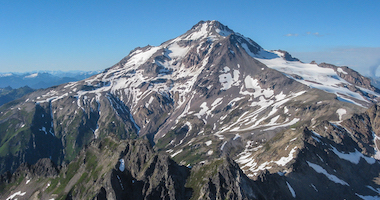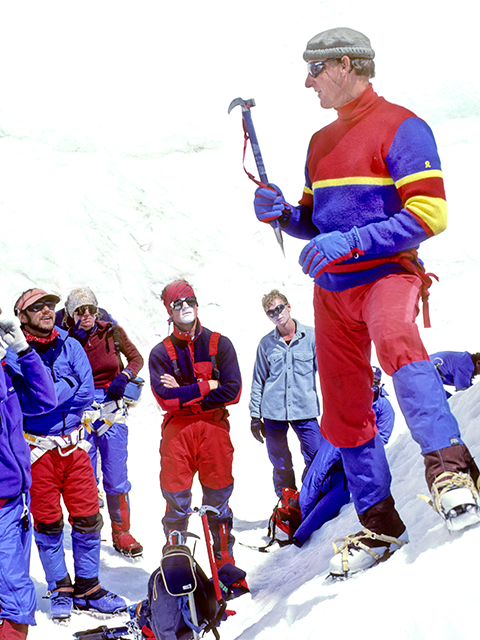Most Popular Entries


Greetings from Puebla! Today was a great day for the team to rest and explore the beautiful city of Puebla. This city is full of history, delicious food, colorful markets and a perfect place to recover for our next climb.
After a day to explore the incredible Catholic Churches built in the 1500s, the team ate dinner together at El Mural de los Poblanos, a fantastic restaurant full of classic local dishes. Puebla is known as the home of Mole.
Our next objective begins tomorrow as we head up to 14,000ft to the high camp on Pico de Orizaba!
Posted by: Brent Okita, Leah Fisher, Nick Hunt
Categories: Expedition Dispatches Mt. McKinley
Elevation: 20,320'

RMI Guide Brent Okita calls in from the descent of Mt. McKinley's summit.
On The Map
Posted by: Dave Hahn, JJ Justman, Mark Tucker
Categories: Expedition Dispatches Everest
Elevation: 4,383'
Your team, the thoughtful decisions you make, and your sensitivity to local conditions and customs are all reasons that RMI enjoys such an enviable safety record and remains the gold standard for guided mountaineering. We all join you in your continuing support for the recovery efforts and in keeping the resilient Nepali people in our thoughts and prayers.
Posted by: Everett Moran on 5/3/2015 at 10:08 pm
So grateful that all of you are safe and on your way home even though your goal of the summit was not to be this year.
Posted by: Susan on 5/2/2015 at 7:19 pm
Posted by: Mike King
Categories: Expedition Dispatches Torres del Paine


We got a casual start today. The day’s hike was approximately 8 miles to Paine Grande Refugio. We walked through the rolling and rocky hillside along Lago Grey. The landscape is mostly barren due to the 2011 fire that swept through the frontside of the “W”. The paste green colors of Lago Grey and the floating icebergs from glacier Grey took up most of our views. As we descended towards the Refugio we got a nice view of Lago Peohe (pay-way). Short day has us enjoying views of the Horns and Paine Grande, while some rain hits the windows of the bar, finally some traditional Patagonia weather.
Everyone is doing well and tomorrow we’ll see what the weather does regarding hiking into the French valley. Thanks for following along.
RMI Guide Mike King & Team
The All-Women’s Expedition Skills Seminar – Paradise led by RMI Guide Devin Wilkinson wrapped up their week by climbing to Ingraham Flats to watch the sunrise. Warm temperatures and overhead hazards on the climbing route prevented the team from reaching the summit safely.
The team has spent the last five days on the upper slopes of Mt. Rainier developing their expedition skills beginning with ice axe use and cramponing techniques and moving on to more advanced skills such as anchor placements, various self and team crevasse rescue techniques, steep technical ice climbing, belays, rappelling, knots, route finding and fixed rope travel. Evening lectures in camp include group discussions on mountain weather, medicine for mountaineering, altitude wellness and equipment.
Congratulations to our All-Women’s team!
Congratulations to this incredible group! Thanks for the post and sharing the photo. Spectacular!
Posted by: Barbara McQueeney on 8/14/2021 at 4:12 pm
Proud of everyone! Amazing accomplishment nonetheless!
Posted by: Kimmy on 8/14/2021 at 1:18 pm
Posted by: Pete Van Deventer, Abby Westling, Ben Luedtke, Josh Geiser, Lily Emerson, Michael Murray
Categories: Expedition Dispatches Mount Rainier
Elevation: 14,410'



The Four Day Climb August 18 - 21 reached the summit of Mt. Rainier this morning at 6:05 am. The teams enjoyed clear skies and a light breeze during their climb. They began their descent from the crater rim at 7:20 am to return to Camp Muir. At Camp Muir they will repack and take a short break before continuing the final 4,500' descent to Paradise.
Congratulations to today's climbing teams!
Photo credit: Ben Luedtke

100% team success on Pico de Orizaba!! We really had to dig deep for this one, but the months of training, hard work, and discipline landed us on top of the third tallest peak in North America today.
From Piedra Grande we head straight up an old aqueduct turned trail with loose rock and scree covering the winding trail. Ixta had us prepared for this though and the team made short work of the trail and up to the base of a feature called the Labyrinth. True to its name it’s a winding maze like feature made of rock that ascending teams must scramble and navigate in order to gain access to the glacier above. Once there, the never ending descending escalator begins. It takes us about three and half hours to climb from base to top. With no good place to take a break, it’s certainly a marathon. The team dug deep, pulled together and summitted the highest point in Mexico.
Congratulations! Awesome job. Looks like it was a beautiful day up there.
Posted by: Patrick Johnson on 3/5/2022 at 10:00 pm
Posted by: James Bealer, Ben Luedtke, Sam Hoffman, Josh McDowell, Trevor Katz, Nick Sinapius
Categories: Expedition Dispatches Mount Rainier
Elevation: 11,400'
Today's Four Day Climb May 31 - June 3 reached 11,400' today before deciding to turn around due to high avalanche danger and deteriorating weather. The teams returned to Camp Muir and packed up. They started their descent to Paradise at 8:30 am. RMI Guides James Bealer and Josh McDowell reported that the winds were high and it was snowing hard as the team left Camp Muir on their descent. Once back at Paradise the teams will be shuttled back to Rainier BaseCamp for a closing ceremony.
Posted by:
Categories: Guide News Responsible Climbing
Posted by: Casey Grom
Categories: Expedition Dispatches Kilimanjaro



Hello again everyone,
Today we visited the famous Ngorongoro Crater, one of the 7 natural wonders of the world. The crater is roughly 100 square miles and is home to more than 25,000 animals that reside here year round, as its one of the few places that has natural springs. We started early with hopes of catching a few big cats before the heat of the day sent them in search of shade.
We saw many hyenas, jackles, ostrich, plus countless other huge birds, and even managed to get close to a large pride of lions with very full bellies. There was a Black Rhino spotted not to far off of the road also which was a highlight.
We wrapped up the day with a visit to a Maasai village not far from the crater's rim. The Maasai people are a semi-nomadic tribe that exist almost entirely off of their cattle. The team spent time asking questions and enjoyed being shown around their small and simple village.
We have just finished another wonderful meal here at the plantation lodge and the team is off to bed after a long, but very rewarding day on safari.
RMI Guide Casey Grom and the safari crew

























Leah, thank you for taking our picture on the summit.
Brent, as one of your former clients on a skills seminar I just wanted to say thank you for teaching me the skills to allow me to summit Denali. It was an honor and privilege to meet your team on the football field and share the summit with you all.
Great job team RMI!
Posted by: Dan Crouch on 6/10/2014 at 5:25 am
Congratulations to the entire team. JOB WELL DONE. Continued safe travels in your entire journey home. Godspeed to you all.
Posted by: Mark DiLucca on 6/6/2014 at 8:45 am
View All Comments